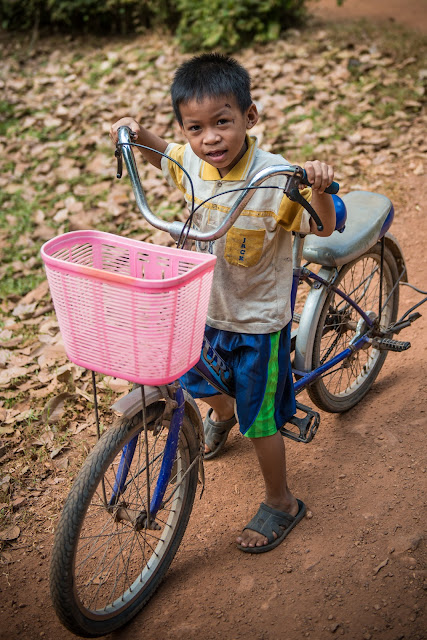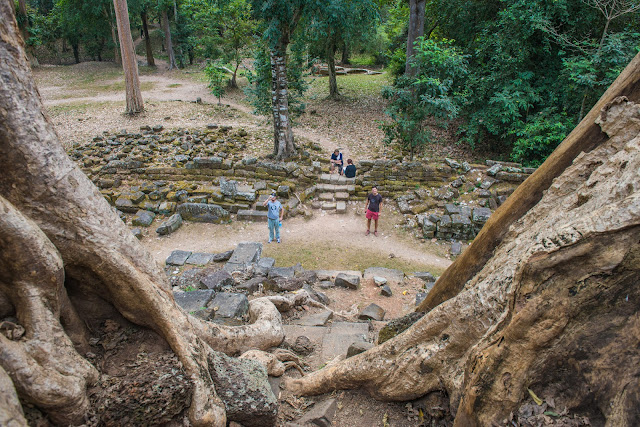 |
| Ankor Wat at sunrise. |
On the bus from Phnom Penh to Siem Reap, I met another American - Mike; he was on holiday from teaching English in northern Thailand and we spent most of the ride talking before sharing a tuk-tuk into Siem Reap town. I was on my way to meet Lars again, who was already a day or two ahead having come straight to Siem Reap after Sihanoukville, rather than detour through the capital like I had done. The tuk-tuk driver didn't know where my guesthouse, Villa Anjuna, was; so I was dropped off close-ish and found it myself on foot down dark alleys, having asked a number of Khmers along the way. I found Lars propped up on the bar and deep in German conversation when I arrived, having walked through a dark garden, guided by the lights of the bar to reach him. I spent five days in Villa Anjuna, and I'm not sure where the time went, as I really only left the security of the compound once in five days to visit Ankor Wat, save one afternoon trip into town to arrange journey onwards to Thailand and to enjoy some bartering in the central market.
Villa Anjuna was a really comfortable and unusual place, it was quiet and tranquil, only having about five rooms or so, and as such all guests hung out and became a group of one, including Mike who wasn't sleeping there but spent a lot of his time within the walls of the villa. It was a German run place, by a very warm and welcoming couple, who'd whip out the Mekong whiskey at any opportunity, and often they'd pour out shots for breakfast. The social area centred around the bar which was constantly trickling out soft Goa trance from the speakers, and the rest of the compound was a carefully cultivated garden designed for psychedelic stimulation. He was a pharmaceutical psychonaut with wild and enthusiastic eyes, and she was his heroin-thin spaceship passenger. They ran the place marvellously, it oozed hospitality with ease and genuine warmth. The menu for cerebral stimulation was as large as the menu for culinary stimulation, and staying there was an experience I will never forget. The days and nights were spent chatting away with the fellow guests, including a middle aged German couple on their honeymoon, some Scandinavians and a mixture of other nationals who came and went, including the night time expat bar visitors, who mostly seemed to be teachers or journalists, so conversation was always good.
 |
| The psychedelic Villa Anjuna garden. |
In the middle of our stay we decided to visit Ankor Wat, which was the purpose of visiting Siem Reap but sometimes you can become distracted. Lars, Mike and I did the trip together, taking a 5am tuk-tuk to the site so we would be there to watch the sunrise. We arrived before there was even really a blue-bleed to the sky, though it wasn't long before the watery hues of dawn began to seep in. As you approach the main entrance to Ankor Wat, having already entered the commercial entrance where you pay $20 for your ticket; there are two small lakes, one on the left and one on the right. The lake on the left already had a small crowd gathered around it bigger than some League Two attendances, whereas the lake on the right only had a handful of people scattered as if picnicking in a park. The choice was obvious. We went and sat on the quiet side and waited for the sun to rise. Having been content with my pictures from a pleasant but unspectacular dawn, we wandered over to the side packed with tourists; DSLRs on auto and compact cameras firing their flashes at a building 250 metres away. Yes I'm a photography snob: deal with it. I took a few pictures of the crowds which by now I found more interesting than the ancient ruins to my left, but we didn't stay with the crowds long before the lure of Ankor Wat was too much to bear and we wandered into the first complex.
 |
| Cambodian dawn. |
 |
| Bigger than some League Two football attendances - the dawn crowds at Ankor Wat. |
Even at the time of writing now, I still don't know too much about Ankor Wat, I've not even gone as far as Wikipedia for research, but you can do that. From what I gather it's around 1000 years old, it started originally as a Hindu religious site, and over time and as influences changed it became a Buddhist site; some of the iconography was changed, others remained, and so it's a mixture of the two Eastern and linked religions. I don't know what society built it, except that the women in the carvings looked Khmer (Cambodian) to me; and judging by the variety in style and decay of the buildings and complexes across the huge site, I would guess they were in use for 500 years or so. This is guess work from my own eye, I can be my own Indiana Jones, perhaps the truth isn't too important; just that the buildings are fascinating, beautiful and intricate. I don't know if they were palaces for Kings or temples for monks, or both, but whatever it was for was clearly deemed very important. I wondered where the ordinary people would have been, as you'd need a city of construction workers and craftsmen to construct such wonders, but I guess the structures they inhabited were temporary. One thing I did notice, and particularly enjoyed considering the way I grew up, was that in many places the floor was littered with pottery. This made me hard. Half the time my eyes were down on the ground looking for any interesting pieces; rims, bases or bits with decoration - just as I had spent countless afternoons as a kid looking for Roman pottery on the fields around where I grew up. This was the evidence of the ordinary people and the occupation of the site. To the untrained eye the ground looked like it was covered in pebbles and gravel, but almost every piece was pot rather than stone, and humble pot at that too. I spent a fair while looking for bits with beauty, and most of it was undecorated and uninteresting, suggesting the consumption of these objects was by ordinary people, workers, not people who lived in world wonders.
 |
| Mostly pottery under your feet. |
Anyway, our tuk-tuk driver remained with us all day, taking us to about five different temple complexes throughout our visit, until around 4pm when our legs were tired and my interest was waning and I didn't want to become bored by it (we'd been looking at it for nearly 11 hours), so we decided to leave. We had intentions to perhaps come back later in the week, but we never made it. One day was enough, plus it'd be another $20 and my financial tank was already running on fumes only. The complexes we visited all had their own character, with different styles and ages, and you could spend up to an hour walking amongst the various crumbling structures within each complex, and sometimes when we were lucky there were hardly any other tourists about. Although thousands of tourists visit Ankor Wat every day, it's such an enormous site, with structures spread out over such an area that you really need transport to even carve off a small slice of it in one day, and as such you can find yourself at quiet spots to selfishly enjoy it.
Now for a barrage of pictures.
Thanks for sticking with me.
Lars and I opted to depart Siem Reap at a comfortable time in the morning, nothing too early and severe, as we headed via bus to the border on our way to Bangkok. I'd heard that this border crossing was one of the more testing in the region, simply because of the volume of people and as such there are often queues and delays. I guess it took us an hour or two to exit Cambodia and enter Thailand, it wasn't too bad. By mid afternoon we were officially in Thailand and looking for options to get to Bangkok. We were too late for the last train of the day, so joined one of the minibus runs which dropped us off adjacent to Khao San Road in Bangkok come evening. The following is the last picture I took on my camera of my entire trip. It's of Lars, as we are approaching the Cambodian border exit. I intended to take photos in Thailand too, but I never got around to it, perhaps because it's the only country on my trip I'd visited before, or that I knew my computer and hard drives were absolutely full, I don't know, but my final two blog entries from this trip will be prose only.
 |
| The last photo from nearly 7 months of travel - Lars with his luggage. |













































No comments:
Post a Comment